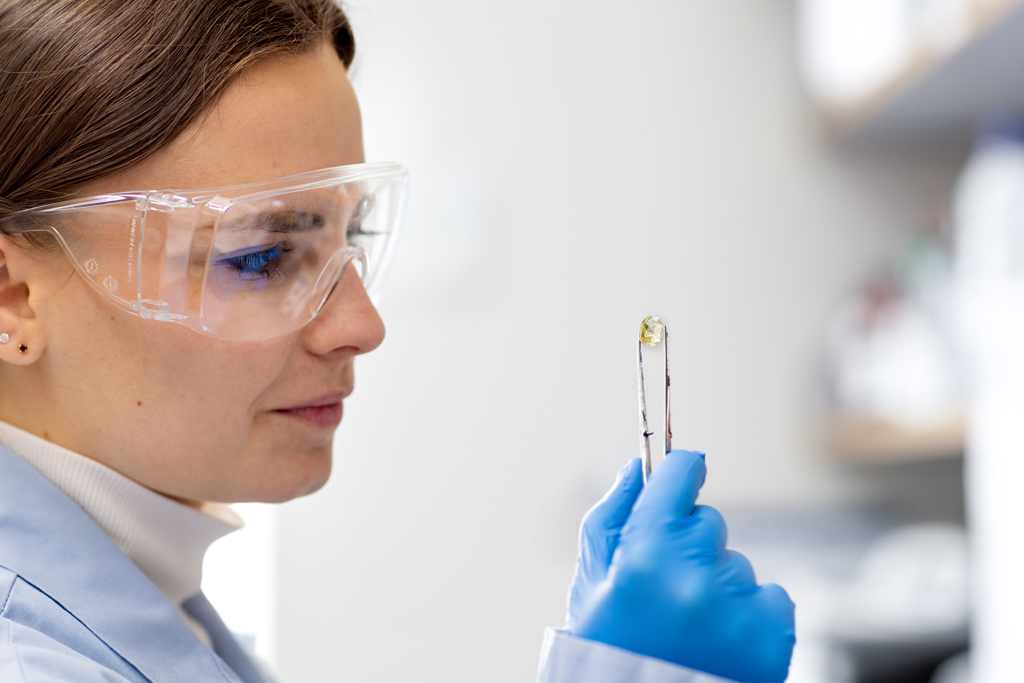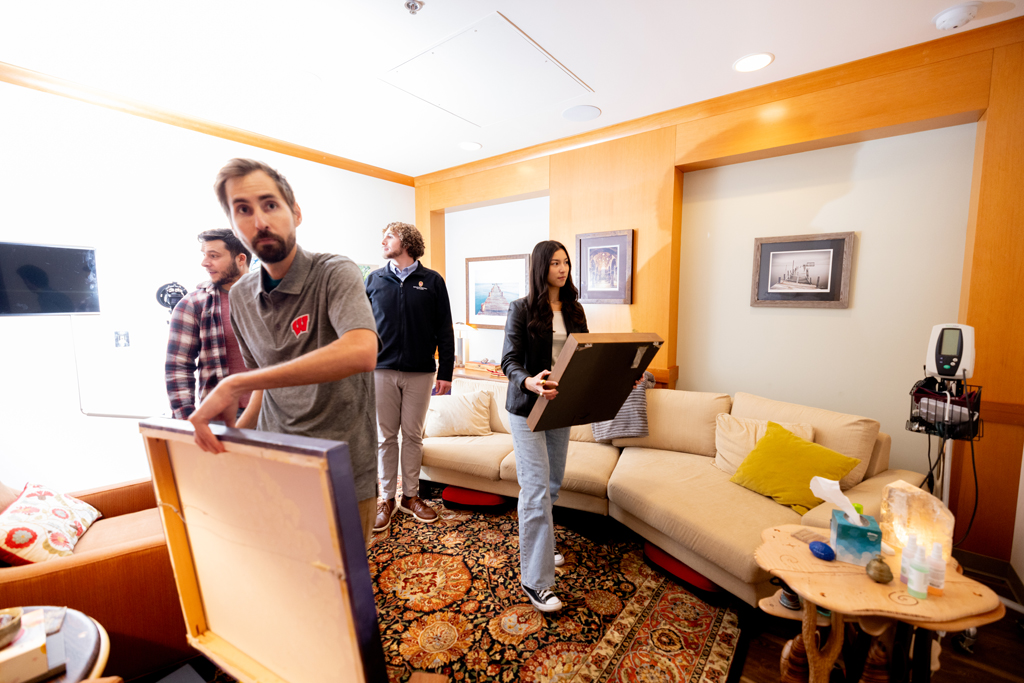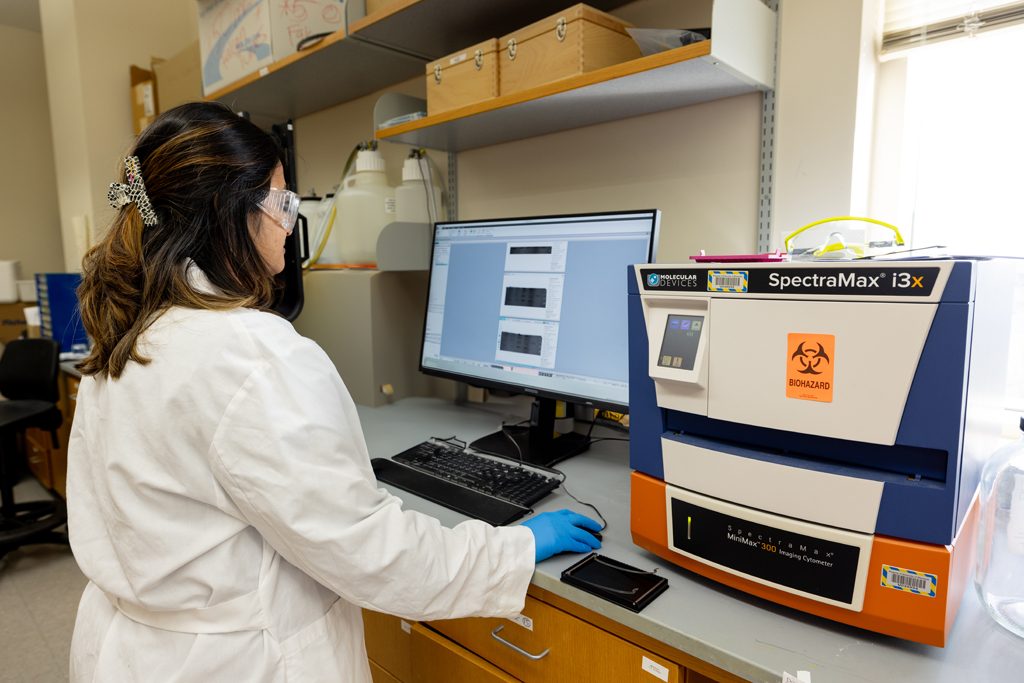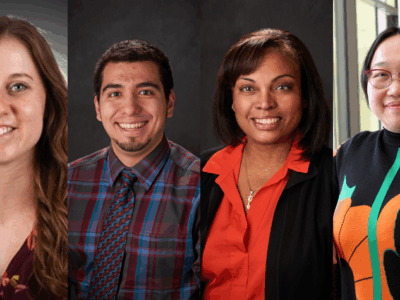
8
March

School of Pharmacy Assistant Professor Cody Wenthur and his team explore how psychedelics can improve mental health disorders. Here’s how they do it.
By Nicole Etter
On any given day, research in the Wenthur Lab might involve everything from rodents skittering through a chambered box in the vivarium to human patients settling onto a comfy couch for a session in the psychedelic-assisted therapy room. Overseeing it all is Cody Wenthur, an assistant professor in the University of Wisconsin–Madison School of Pharmacy’s Pharmacy Practice and Translational Research Division. Wenthur serves on the executive board of the UW Transdisciplinary Center for Research in Psychoactive Substances and directs the School’s master’s program in Psychoactive Pharmaceutical Investigation.
There is no shortage of research questions to explore in this fast-growing area, where UW–Madison has long been a pioneer. The Wenthur Lab is working on nine projects across three key areas: clinical uses and applications, psychoactive drug mechanisms, and tool development and synthesis.
“It’s fantastic to be housed in a building and engaged with colleagues where that breadth of work can be done,” Wenthur says. “We have a really incredible and rare set of resources.”
Wenthur’s research team of 15 draws from several programs on campus, including public policy, as research explores the ways in which society accepts or rejects certain uses of psychoactive drugs.
“I think ultimately what makes the lab such a vibrant and active place is we’re cross-pollinating between different programs and perspectives,” says Wenthur.
Here’s a peek at the inner-workings of the Wenthur Lab.

Uriel Matthew Enriquez, a graduate student in the Pharmaceutical Sciences PhD Program, washes a round-bottom flask with acetone. Using organic chemistry approaches, Enriquez synthesizes small molecules called haptens to use to detect novel substances, including psychoactive tryptamines and dissociative hypnotics.
“That’s important because some people are misusing these tryptamines, and new versions of them are coming up all the time,” Wenthur explains. “We’re also interested in using those tools to understand the mechanism of action for complex psychoactive mixtures. Sometimes there’s more than one molecule there. Sometimes the metabolite itself is active.”

Noelle Cataldo, a graduate student in the Molecular and Cellular Pharmacology Training Program, rinses off a pair of forceps. Cataldo’s lab duties include using neuroimaging on cleared whole brains and organoids to identify patterns of neurons that are activated under the influence of psychedelics and ketamine.
“Psychedelics are currently being explored as adjuncts to therapy for clinical use, but their mechanisms of action and how they’re doing that remain incompletely described,” Wenthur explains. “Some of the interesting things that we’re seeing is there are different regions activated by ketamine and one of its active metabolites, hydroxynorketamine. And we think that those are contributing independently to the rapid-acting antidepressant effects of ketamine.”

Cataldo examines a brain of an animal model that has been rendered optically clear by extracting the lipids.
“It’s labeled with fluorescent antibodies so we can see the neurons that have been activated,” Wenthur says. “It really seems like science fiction. The method that we use to do that is called iDISCO. To get it totally transparent, you want to match the refractive index of the solution that you put it in. The solution that matches the refractive index of this brain is called ethyl cinnamate, and it smells like cinnamon.”

Cataldo studies a fluorescent image from a cleared brain, looking for markers of neuronal activation in the hippocampus.
“We’re trying to connect the dots from drugs that change human or animal behavior,” Wenthur says. “We can certainly observe the behavioral changes that are arising, but it’s helpful to understand at a neural level how that is actually occurring. This can tell us about which parts of the brain are important for which behaviors, and if we intervene with potential therapeutic options, how that’s modifying behavior within that circuitry to give us a better sense of targets for next-generation therapeutics for conditions like addiction or mood disorders.”

Wenthur talks with Suhjung Janet Lee, a graduate student in the Neuroscience and Public Policy Program. The pair stand in front of conditioned place preference equipment in the vivarium, where the lab conducts research using animal models.
“We’re using this equipment to understand mouse behavior as it relates to reward from things like opiates,” Wenthur explains. “We’re trying to understand if different types of opiates or other types of interventions can mitigate the rewarding outcomes from opiate administration.”

Lee places a mouse into the conditioned place preference equipment. The box is divided into walled chambers, and the floor is either bumpy or smooth. The researchers give the animal a simple saline solution when it’s in one chamber and an opioid when it’s in the other, and then they repeat the process over several days until the animal learns what to expect. Then, researchers remove a wall to allow the mouse to move freely around the box.
“It will want to spend more time over in this chamber where it received the opioid,” Wenthur says. “So you can use it to understand the reward that’s being created by a given compound. And then if you intervene with something else in between the training and the test, you can see what effect that has on the pressure system.”

Wenthur talks with Nicole Stigler (middle), an undergraduate research assistant, and Natalie González Velázquez, a graduate student in the Pharmaceutical Sciences PhD Program, as they look at operant conditioning boxes used to study rat behavior. Gonzalez-Velazquez is studying ketamine self-administration in rats and whether metabolite hydroxynorketamine is playing a role in that self-administration.
“This equipment is also used to understand learning behavior associated with threat responses, which is important for anxiety behaviors and treatments like exposure therapy for PTSD,” Wenthur says. “We can use animals to look at the circuits that are underlying that learning and relearning behavior and then look at different drugs to see how they may accelerate the loss of fear.”

González Velázquez (left) and Stigler test equipment in the operant condition chamber in the vivarium. The room is lit red because rodents are nocturnal and can’t see red light very well, so it feels like nighttime to the rats while providing enough light for researchers to work.

Wenthur selects a photo from a digital display in the School of Pharmacy’s psychedelic-assisted therapy space. The School of Pharmacy worked with Community Advisors on Research Design and Strategies (CARDS) and the Chazen Museum of Art to create a library of images that study participants can use to customize the environment.
“The reason that we’re doing this is because the demographics of folks showing up in psychedelic trials are wildly unrepresentative, and we’re trying to make this space more comfortable and appealing for folks with a variety of different self-identities,” Wenthur explains.

Wenthur and his team (left to right in the background: Nate Jones, a graduate student in the Molecular and Cellular Pharmacology PhD Program, and PharmD students Blake O’Connor and Sophia Castillo) consider where to hang new art in the psychedelic-assisted therapy room. The lab team worked with CARDS to highlight a diverse range of local artists to make the space feel more welcoming and inclusive.
This room was the site of the first-ever Phase 1 psilocybin pharmacokinetic dosing study, under the direction of Paul Hutson, professor of pharmacy practice, and others, and it continues to be used regularly by many investigators affiliated with the Transdisciplinary Center for Research and Psychoactive Substances. Most recently, UW investigators have used it for studies of psilocybin to treat opioid and methamphetamine use disorders and major depressive disorder, as well as MDMA-assisted therapy for PTSD.

Enriquez works with liquid chromatography-mass spectrometry, an analytical chemistry technique, to check the progress of a reaction he’s testing, verify the identity of the compound that he is synthesizing, and ensure that his sample is free of impurities.
“This is a shared piece of equipment through the Medicinal Chemistry Center, which has been a fantastic resource for us,” Wenthur says.

Jillian Kyzer, a medicinal chemist and staff scientist in the Wenthur Lab, synthesizes a click chemistry reaction to form probes for receptors and the reward center of the brain.
“Basically, we’re trying to develop new tools that can work for stimulant use disorders,” Wenthur says.

Another view of Kyzer’s work in the chemical fume hood, which limits the research team’s exposure to potentially hazardous fumes, vapors, and dust.

Riya Bhavsar, a technician in the Wenthur Lab, studies Western blot data.
“She’s measuring the levels of proteins and changes from tissues extracted from the brain to see how stress-associated markers change in response to drug treatment,” Wenthur says. “And one of the interesting things we found here is that, at least in our models, it looks like the stress that the psychedelics induce is actually an important component of how they result in long-term reductions in anxiety.”






